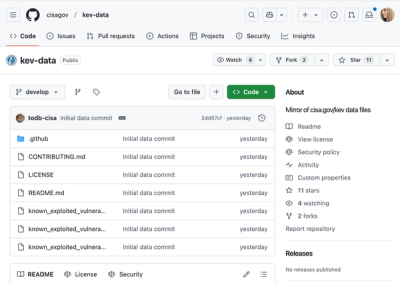
Security News
CISA Brings KEV Data to GitHub
CISA's KEV data is now on GitHub, offering easier access, API integration, commit history tracking, and automated updates for security teams and researchers.
graph-wrangle
Advanced tools
A command-line tool and library for wrangling network graph data
$ npm install graph-wrangle
For drawing graphs, node-canvas is used which requires Cairo and Pango. For details about setting up node-canvas, see their documentation. To install Cairo and Pango on OS X run: brew install pkg-config cairo pango libpng jpeg giflib.
From a command-line:
graph-wrangle style -i examples/data/100nodes.json -k genre_like | \
graph-wrangle layout -a force-atlas2 -t 200 | \
graph-wrangle draw -o my_graph.png -w 600 -h 600
Using a pipeline config file (typically named graph-wrangle.config.json or .js)
graph-wrangle pipeline --config graph-wrangle.config.json
See the examples folder for example pipeline config JSON and sample graph datasets.
Note that depending how you installed it, you may need to run bin/graph-wrangle.js instead of just typing graph-wrangle.
Run a pipeline with generated output filenames based on the input filename. Available tokens in the pipeline config json are:
Example usage:
graph-wrangle pipeline --config examples/pipeline_shared_io.json -i examples/data/100nodes.json
You can specify multiple files to run in succession by passing multiple -i <file> arguments.
graph-wrangle pipeline --config prepare-graphs.json \
-i week-31-bundle.json \
-i week-33-bundle.json \
-i week-35-bundle.json
Note that globs are also supported:
graph-wrangle pipeline --config prepare-graphs.json -i "week-*-bundle.json"
For later animation, it can be helpful to precompute differences between sequential pairs of graphs. Use the sequence command to do so.
Example usage:
graph-wrangle sequence -o sequence.json graph1.json graph2.json graph3.json
With globs too:
graph-wrangle sequence -o sequence.json "graph*.json"
FAQs
A command-line tool and library for wrangling network graph data
The npm package graph-wrangle receives a total of 9 weekly downloads. As such, graph-wrangle popularity was classified as not popular.
We found that graph-wrangle demonstrated a not healthy version release cadence and project activity because the last version was released a year ago. It has 1 open source maintainer collaborating on the project.
Did you know?

Socket for GitHub automatically highlights issues in each pull request and monitors the health of all your open source dependencies. Discover the contents of your packages and block harmful activity before you install or update your dependencies.

Security News
CISA's KEV data is now on GitHub, offering easier access, API integration, commit history tracking, and automated updates for security teams and researchers.

Security News
Opengrep forks Semgrep to preserve open source SAST in response to controversial licensing changes.

Security News
Critics call the Node.js EOL CVE a misuse of the system, sparking debate over CVE standards and the growing noise in vulnerability databases.